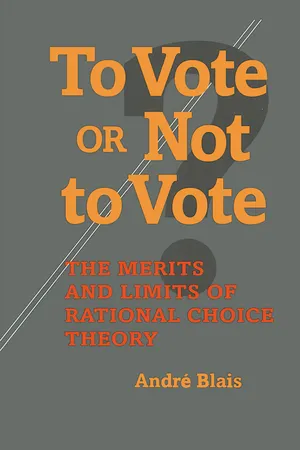
- English
- PDF
- Only available on web
About This Book
What makes people decide to vote? In addressing this simple question, Andre Blais examines the factors that increase or decrease turnout at the aggregate, cross-national level and considers what affects people's decision to vote or to abstain. In doing so, Blais assesses the merits and limitations of the rational choice model in explaining voter behavior. The past few decades have witnessed a rise in the popularity of the rational choice model in accounting for voter turnout, and more recently a groundswell of outspoken opposition to rational choice theory. Blais tackles this controversial subject in an engaging and personal way, bringing together the opposing theories and literatures, and offering convincing tests of these different viewpoints. Most important, he handles the discussion in a clear and balanced manner. Using new data sets from many countries, Blais concludes that while rational choice is an important tool—even when it doesn't work—its empirical contribution to understanding why people vote is quite limited. Whether one supports rational choice theory or opposes it, Blais's evenhanded and timely analysis will certainly be of interest, and is well-suited for advanced undergraduate and graduate-level classes.
Frequently asked questions
Information
Table of contents
- Contents
- Preface and Acknoledgements
- Introduction. Is it Rational to Vote?
- 1. When and Where are People More Likely to Vote?
- 2. Who Votes?
- 3. Do People Believe that their Vote Could Be Decisive?
- 4. What is the Cost of Voting?
- 5. Is it a Duty to Vote?
- 6. Do People Free Ride?
- Conclusion. Rational Choice and Voting
- Appendix A. Democratic Elections, 1972-95, and participation Rate
- Appendix B. Variables, Indicators, and Sources
- Appendix C. 1993 Study of Electoral Participation amond University Students: Research Design
- Appendix D. 1993 Study of Electoral Participation among University Students: Question Wording
- Appendix E. CSES Data, 1996-2000: Description of Variables
- Appendix F. 1995 Study by Thalheimer on the Importance of P in the Decision to Turn Out: Question Wording
- Appendix G. 1995 Quebec Referendum Study: Question Wording
- Appendix H. 1996 British Columbia Election SWtudy: Question Wording
- Appendix I. 1996 Blaid and Thalheimer STudy on Reasons for Voting: Question Wording
- Notes
- References
- Index